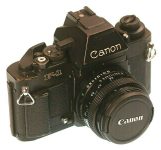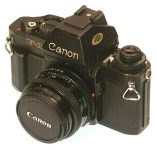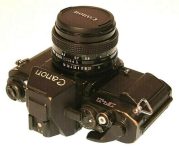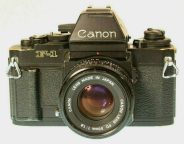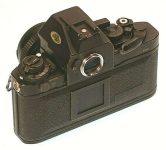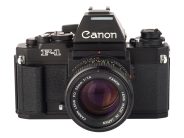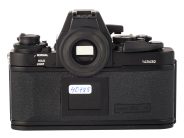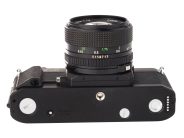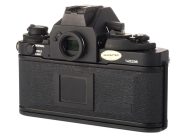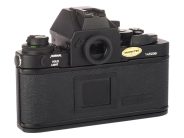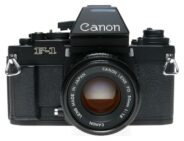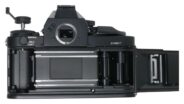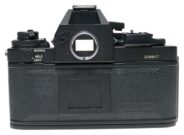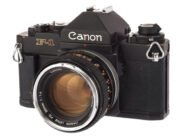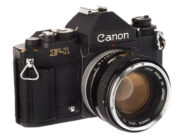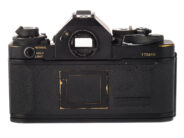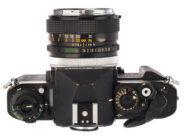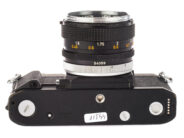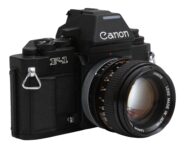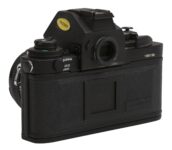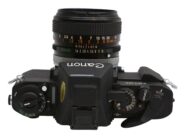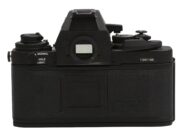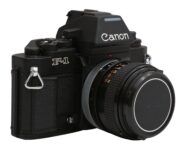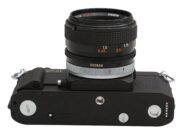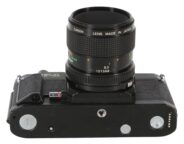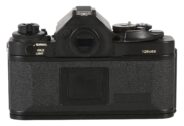Canon New F-1
35mm MF film SLR camera
Specification
| Production details: | |
| Announced: | September 1981 |
| System: | ● Canon FD (1971) |
| Format: | |
| Maximum format: | 35mm full frame |
| Film type: | 135 cartridge-loaded film |
| Mount and Flange focal distance: | Canon FD [42mm] |
| Shutter: | |
| Type: | Focal-plane |
| Model: | Electronically controlled |
| Speeds: | 8 - 1/2000 + B |
| Exposure: | |
| Exposure metering: | Through-the-lens (TTL), open-aperture |
| Exposure modes: | Manual |
| Physical characteristics: | |
| Weight: | 795g |
| Dimensions: | 146.7x96.6x48.3mm |
Manufacturer description #1
Instead of being a next-generation successor to the F-1, this camera was called the “New F-1,” and not the “F-2.” With the first F-1 in 1971, Canon promised that the camera would remain unchanged for 10 years. This promise was fulfilled. During those ten years, there were remarkable advances in electronics, precision manufacturing, and optics. The successor to the top-of-the-line F-1 had to incorporate the best electronic technology for better automation, versatility, and specifications.
For metering flexibility, the New F-1 uses interchangeable focusing screens to change the metering pattern with a segmented metering element. For automation, system AE is incorporated for optimum operation. The camera’s basic controls are also the same as the old F-1 so F-1 users can easily adapt to the New F-1.
Manufacturer description #2
The new F-1 is Canon's top-of-the-line professional camera. It is introduced as the successor to the original F-1 which, since its introduction in 1971, has become the mainstay system camera for growing numbers of professional photographers in all fields.
Continuing the unmatched tradition of durability and reliability established by its predecessor, the new F-1 will function perfectly for a minimum of 100,000 exposures. It has successfully undergone a demanding series of vibration, shock and operation tests as well as temperature testing between -30°C (-22°F) and +60°C (140°F).
Contributing to this impressive record are several revolutionary advances in production technology. These include the computer-controlled NC (Numerical Control) machine which performs a variety of grinding, milling and drilling functions, primarily on the die-cast body and AE Finder FN. The machine is also used for precision milling of individual parts. Other advances include the use of laser welding instead of conventional rivets, and burnishing of the inner surface of shafts by forcing ball bearings through under high pneumatic pressure.
Special measures are taken to protect the new F-1's sophisticated electronic circuitry inside, against vibration and moisture. Plastic and rubber seals prevent entry of dust and moisture from locations such as the shutter release button and dial to protect interior parts. And the shutter curtain control magnets are silver-plated to ensure better contacts and longer life cycle. Elastic connectors instead of solder connectors are used to connect the main PC board to the resistor board and other flexible circuit boards provide extra shock protection.
The new F-1 has two IC's, one for the photometry circuit with an analog operational amplifier to perform exposure calculations based on the subject illumination, shutter speed, aperture and ASA settings and the other a digital control circuit which controls the shutter speed, electromagnetic release, self-timer and exposure meter. These circuits also monitor the control status of both the camera and its accessories. The "Check and Go" system of electro-mechanical sequences checks each camera operation and function to determine whether it was normal or not before passing to the next stage. "Check and Go" is executed in three steps: prior to shutter button release, prior to making exposure after first press of the shutter button and prior to winding the film to next frame in continuous shooting.
Multiple AE Modes Plus Manual
Versatility comes in the form of system accessories which, besides fulfilling their basic functions, also provide additional AE modes. Thus, attaching the AE Motor Drive FN not only permits powered film advance but gives you shutter-priority AE, as well. Similarly, replacing the standard Eye-level Finder FN with the AE Finder FN makes possible aperture-priority and stopped-down AE.
1. Manual
The mode which puts you in total creative control.
Your customer has a choice of either full-aperture metering or stopped-down metering. The meter is activated by gently depressing the shutter release button. Turn the aperture ring so that the aperture needle matches the meter needle (or meter needle cuts the fixed index in case of stopped-down metering) for correct exposure.
2. Shutter-priority AE
The ideal mode for action photography. This kind of photography also calls for rapid film advance, so Canon decided to combine the two. Shutter-priority AE is attained by attaching either the AE Motor Drive FN or AE Power Winder FN. For this mode select a shutter speed and set the lens aperture ring to "A". Shutter-priority AE is possible with any of the 5 interchpngeable viewfinders installed.
3. Aperture-priority AE
Aperture-priority AE is provided by installing the AE Finder FN. Set the shutter dial to "A" and select the desired aperture. The exposure information display shifts from the right side to below the image. The AE Finder FN also makes feasible stopped-down AE which is a convenience in close-up work.
4. Multiple Exposure Modes
For the photographer who demands maximum exposure mode flexibility, the new F-1 is the perfect system camera. Attaching either of the two power drives and the AE Finder FN gives three AE Modes (shutter-priority AE, aperture-priority AE and stopped-down AE) plus manual. For others, such as sports or news photographers who are more concerned with capturing fast action scenes, the power drives' shutter-priority AE capability will usually suffice.
Reliable Electromechanical Hybrid Shutter
The new F-1 has an electromechanical hybrid shutter. The fast speeds from 1/2000 - 1/125, ↯ (1/90) and B are mechanically controlled, whereas electronic circuitry controls the slower speeds from 1/60 to 8 secs. With the AE Finder FN set for aperture-priority and stopped-down AE, all shutter speeds become electronic, although in this case the fastest speed is 1/1000 sec. Battery failure, the bane of the professional photographer, thus poses no problem. The battery must be removed for mechanically- controlled speeds in case of battery failure.
Expanded Metering Range
The metering range is a wide EV-1 to EV20 (ASA 100; 50mm f/1.4), permitting shutter speeds of down to 4 seconds. The film speed range is also wider: ASA 6 to ASA 6400.
Choice of Three Metering Areas
Many cameras feature interchangeable focusing screens. The new F-1, however, is the only one that also offers a choice of metering sensitivity patterns, just by changing the screen.
There are three different patterns: center-weighted average, selective-area and spot metering. Dividing the 13 different focusing screens available into three groups yields a total of 32 focusing screen-metering system combinations. The entire series of screens is available for center-weighted average metering and selective-area metering. Six screens - only those effective for this specialized metering method are available for spot metering.
Center-weighted average metering is ideal for AE photography, particularly with wide-angle lenses. The degree of center-weighting in the horizontal direction is significantly increased to minimize exposure difference between vertical and horizontal positions. Selective-area metering is also effective for AE photography and stopped-down AE in close-up applications where precise exposure of a specific area of the image is necessary. Approximately 12% of the viewfinder area is metered. The 3% spot metering pattern is difficult to use, yet yields spectacular results. Ideal for situations where there is extreme contrast between subject and background.
New screens include two Bright Laser-Mattes which are approx. 20% brighter than the laser matte and the Cross Split which facilitates both horizontal and vertical format focusing.
Manufacturer description #3
Type: 35mm single-lens reflex (SLR) camera
Format: 24 x 36mm
Interchangeable Lenses: Canon FD (for full-aperture metering) and Canon FL, R and non-FD (for stopped-down metering) series lenses.
Standard Lenses: FD 50mm f/1.2L, FD 50mm f/1.2, FD 50mm f/1.4 and FD 50mm f/1.8
Lens Mount: Canon breech-lock mount.
Exposure Modes: Match-needle and stopped-down manual exposure. Shutter-priority AE possible by attaching AE Power Winder FN or AE Motor Drive FN and setting lens' aperture ring to "A." Aperture-priority AE and stopped-down AE possible by attaching AE Finder FN and setting shutter dial to "A." AE flash possible with specified Canon Speedlites.
Viewfinder: Interchangeable eye-level pentaprism as standard. 97% vertical and horizontal coverage of actual picture area with 0.8x magnification at infinity with a standard lens. Aperture scale with f/stops from f/1.2 to f/32, overexposure and underexposure warning marks, meter needle, aperture needle and battery check/stopped-down metering index are displayed to the right of the field of view. Shutter speed displayed below aperture scale. Speeds include 1/2000 to 1 sec, ↯ and "B" in green; full seconds of 2, 4 and 8 are in orange.
Viewfinder Illuminator: Provided; illuminates aperture scale and shutter speed for 16 seconds when meter mode selector is set to "LIGHT" and shutter button pressed half-way.
Eyepiece Shutter: Built-in. Keeps out extraneous light during self-timer and remote control operation.
Dioptric Adjustment: Built-in eyepiece adjusted to standard -1 diopter.
Focusing Screen: Standard split-image/microprism rangefinder. Twelve other types of interchangeable screens are optionally available.
Light Metering System: Through-the-lens (TTL) metering by silicon photocell (SPC). Metering area is determined by special optical element incorporated in each focusing screen. Center-weighted average, selective-area and spot metering are optionally available by changing the focusing screen.
Meter Coupling Range: EV -1 (4 sec. at f 1.4) to EV 20 (1/2000 sec. at f/22) with ISO 100 film and FD 50mm f/1.4 lens.
Exposure Preview: By pressing shutter button halfway.
Meter Mode: At "NORMAL," meter activated as long as shutter button is pressed half-way. At "HOLD," meter, once activated, stays on for 16 sec. At "LIGHT," meter, once activated, stays on for 16 secs. and viewfinder information is illuminated. Cancellation possible.
Exposure Compensation Dial: +/-2 f/stop range in 1/3 f/stop increments: 1/4 .. 1/2 .. 1 .. 2 .. 4
Shutter: Horizontal-travel, titanium focal-plane shutter with four spindles. Electromechanical hybrid control. Mechanically controlled at speeds from 1/2000 to 1/125 sec., "↯" (1/90 sec.) and B. Electronically controlled at speeds from 1/60 to 8 secs.
Mechanical Shutter Operation: By removing battery from battery chamber. Only mechanically controlled speeds can be used.
Mirror: Instant-return type with shock-absorbing mechanism.
ISO (ASA) Film Speed Scale: ISO 6-6400.
Shutter Dial: 1/2000 to 8 sec., "A" (for aperture-priority AE or stopped-down AE with AE Finder FN), "B" (bulb) and "↯" (1/90 sec.). Shutter speeds from 1/2000 to 1 sec., "↯" and "B" are in white, 2 to 8 secs. in yellow and "A" is in red.
Shutter Button: Two-step button with electromagnetic release. Mechanical release when battery is removed from the camera. Pressing it halfway activates meter circuit, pressing it fully releases the shutter. Can be locked by setting self-timer/lock lever to "L." With cable release socket.
Self-timer/Lock Lever: Three positions: "A," "L," and "S." At "L," the shutter button is locked as a safety feature. "S" position is for self-timer operation.
Self-timer: Electronically controlled. Self-timer/lock lever set to "S." Activated by pressing shutter button. Ten-second delay with electronic "beep-beep" sound. Number of beeps emitted per second increases two seconds before shutter release. Cancellation possible.
Stop-down Slide: For depth-of-field preview or stopped-down metering.
Power Source: One 6V lithium (Duracell PX 28L), alkaline-manganese (Eveready [UCAR] No. A544), or silver oxide (Eveready [UCAR] No. 544) battery. Battery lasts about one year under normal use.
Battery Check: By pressing battery check button. Battery power is sufficient if the meter needle registers above the battery check index.
Cancellation of Camera Circuit: By pressing battery check button. Cancels shutter operation, self-timer operation, meter reading and viewfinder illumination.
Multiple Exposure: Possible by engaging rewind lever before winding film advance lever to recock the shutter. Cancelled by lightly pressing shutter button.
Flash Synchronization: Speeds up to 1/90 sec. with electronic flash; FP- and M-sync at 1/30 sec. or slower. Direct contact at accessory shoe for hot-shoe flash. Threaded PC socket (JIS-B type) for cord-type flash or multiple flash photography. Accessory shoe has contact for normal automatic flash and special contact for AE flash with specified Canon Speedlites.
Automatic Flash: New Canon Auto Tuning System (New CATS) with specified Canon Speedlites. Shutter speed is automatically set to 1/90 sec. with shutter dial at any setting except B. Meter needle indicates auto working aperture in the viewfinder as soon as Speedlite's pilot lamp glows. Aperture controlled automatically when AE Power Winder FN or AE Motor Drive FN is attached and lens' aperture ring set to "A" mark.
Slow-Sync Flash Photography: Possible with Speedlites 199A, 533G and 577G. Flash synchronizes with shutter speed set at slow settings from 1/60 to 8 secs. Camera switches automatically to 1/90 sec. when shutter dial is set from 1/2000 to 1 125 sec. or "↯"
Camera Back: Opened by pressing safety stopper while pulling up rewind knob. Removable for attaching Data Back FN or Film Chamber FN-100. With memo holder.
Film Loading: Via multi-slot take-up spool.
Film Advance Lever: Single-stroke 139° throw with 30° stand-off. Ratchet winding possible.
Frame Counter: Additive type. Automatically resets to "S" upon opening camera back. Advances during multiple exposures.
Film Rewinding: By turning rewind lever clock-wise and pressing it down and turning rewind crank. Rewind lever automatically resets when camera back is opened and when shutter button is lightly pressed.
Other Safety Devices: Camera will not function when power level is insufficient or when lens' aperture ring is set to "A" and the power winder or motor drive is not attached. Film winding impossible while shutter is in operation.

